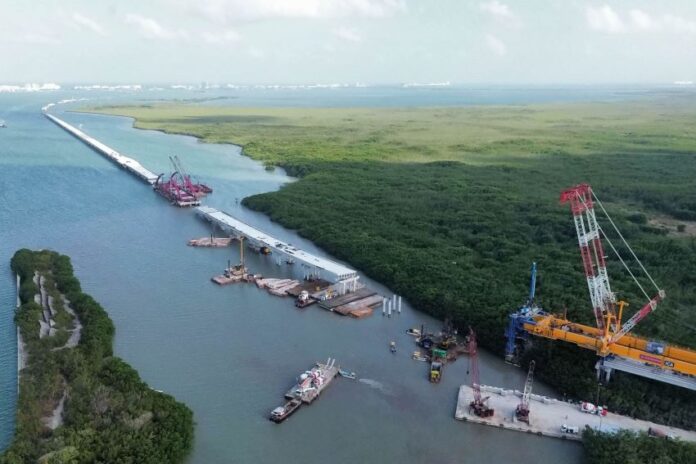By late 2025, Cancún, Quintana Roo, is set to have a new bridge over the Nichupté Lagoon that will connect the resort city to the hotel zone.
The Nichupté Vehicular Bridge, an infrastructure project being developed by the Ministry of Infrastructure, Communications and Transportation (SICT), is expected to benefit 1.3 million residents in Cancún by reducing travel times — up to 45 minutes for daily commuters — once completed.
La magna obra del #PuenteNichupté 🌉 avanza su construcción con tecnología “top down”. Un paso histórico en la modernización de nuestra infraestructura. ¡La transformación con justicia social y el desarrollo sustentable avanza en #QuintanaRoo! #UnidosParaTransformar pic.twitter.com/xBm4S90LBu
— Mara Lezama (@MaraLezama) April 27, 2025
During a site tour on Saturday with President Claudia Sheinbaum and Quintana Roo Governor Mara Lezama, head of SICT Jesús Antonio Esteva Medina said the bridge will be one of the longest bridges over a lagoon in Latin America.
With a total length of 11.2 kilometers, the bridge will connect Cancún’s hotel zone with Colosio Boulevard, Tulum, Kabah and Bonampak Avenues. It will feature an 8.8-kilometer-long bridge, a 103-meter-long metal arch, and two access interchanges, each measuring 2.4 kilometers located on Luis Donaldo Colosio Boulevard and Kukulcán Boulevard. The project will also include a bicycle lane, pedestrian walkways, bus stops and a lighting system.
The bridge will have a 14.9-meter-wide crown cross section with three traffic lanes: one in each direction and one reversible lane, which will be adjusted according to traffic demand. It will be equipped with a state-of-the-art Intelligent Transportation System (ITS), linked to a Command, Control, Communications, and Computing Center (C4), to provide greater safety for residents and visitors during extreme weather.
Furthermore, SICT said it will serve as an alternative evacuation route for the tourist area in case of a natural disaster, contingency or emergency.
According to SICT, the bridge, which will cross the mangrove area at the Nichupté Lagoon, is a sustainable project that represents the Ministry’s largest environmental restoration program, with 306 hectares of mangrove reforestation.
The region is a Protected Natural Area and (ANP) natural area of the broader Nichupté Lagoon System, which plays a crucial role in sustaining the ecological dynamics of the lagoon and the reefs that make up the Costa Occidental de Isla Mujeres National Park, Punta Cancún and Punta Nizuc, all part of the Mesoamerican Reef System (MAR).
Mexico News Daily
